Pilot Your Next Camera With the Best Drones for Flying Enthusiasts

"Hearst Magazines and Yahoo may earn commission or revenue on some items through these links."
Few bits of consumer tech have caught on more quickly than drones—also referred to as quadcopters or quads (colloquially, anyway). These machines can capture cinematic footage of the environment and HD portraits of pilots and spectators. With just a few hundred dollars, you can purchase a drone to shoot stable, striking high-definition video of landscapes, real estate, big groups of people, large events, and whatever else you want a bird’s eye view on.

Their ascent into popularity was just as fast as the advancement of the technical capabilities on consumer drones, especially those that don’t typically require a license or registration to operate. Most of these improvements focused on making them easier to fly, and some offer exceptional safety and accident-preventing features.
The best drones are supremely stable in crosswinds, unlikely to lose connectivity with a controller, and—thanks to onboard GPS—return to where you launched them and land if that connection is broken. Proximity-sensing tech buffers against many of the dangers of accidentally flying into trees and other objects that can cause crash landings. Some shoot video in 4K and even 8K resolution, matching the quality of $1,000-plus DSLR cameras.
With such a wide variety of drones available, you may not know where to begin your journey into flight. Luckily, we’ve talked to plenty of experts who can help.
On the hunt for useful gadgets that serve you? Check out the 2023 Popular Mechanics Gadget Award winners, and our guides to the best gadget gifts and gifts for nerds.
The Best Drones
Best Overall: DJI Mini 2 Drone
Best Value: Potensic Atom SE
Best for Intermediate Pilots: DJI Mavic Air 2 Drone
Best for Professional Use: DJI Mavic 3
What to Consider
For better or worse, one company stands pretty far apart from the others regarding consumer-level drones: DJI. Rivals like Fimi, Potensic, and Autel have their own decent offerings, but DJI is considered the standard in aerial drones.
Avoid purchasing a drone from a brand without a longstanding, reliable reputation—these tend to have low runtimes, shoddy parts, and unreliable controllers.
Budget and Use
When buying any photography equipment, you should choose the one that best fits your needs—in other words, the one that you’re most likely to use. An expensive, high-end model could be great for pro-level video, but you might not want to use it for speed running around a park.
For recreational use, there are more affordable, more portable drones that you can easily pack for trips. That’s not to mention that you also have a much higher likelihood of crashing it if you're starting out.
For most consumer pilots, a drone between $400 and $1,500 will do you just fine. Most drones within this budget range have a flight time of around 30 minutes and can fly at least a few miles away. As you move up through that price range and beyond, you’ll get better cameras and more advanced flight capabilities—including subject tracking and obstacle avoidance.
Pricier drones that can handle intense winds and go further are often bigger, too; however, most large drones, as well as the pilots flying them, must be registered with the FAA before you take off. We only recommend large drones for professional drone pilots.
Regulations
Even the most affordable drone is considered a vehicle, not a toy, so follow all the local regulations when flying one. In the U.S. and Canada, that starts with registering your drone for a nominal fee if it’s above a certain weight (250 grams, or 8.8 ounces, in both countries). You’ll need drone piloting certification from the FAA to fly any unmanned aerial vehicle, and regardless of its size or use, register it with the FAA.
Both countries share a few guidelines. Here’s a quick rundown of common regulations, and good safety advice to follow regardless:
Always keep your drone within your line of sight.
Don’t fly near airports or other restricted areas, including near emergency response efforts.
Don’t fly higher than 400 feet.
Don’t fly over pedestrians or moving vehicles.
Don’t operate your drone while under the influence of drugs or alcohol.
There are hefty fines for violating the rules, so you should familiarize yourself with them, especially before you fly in a new location. Most of the drones we recommend come with built-in safety features, too—for instance, the DJI drones won’t take off if you’re in a no-fly zone, such as near an airport or government building. In terms of etiquette (and avoiding a lawsuit), it’s best not to fly closely over homes or other private property, especially when you’re recording video.
You can find the full guidelines for the U.S. and Canada from the FAA and Transport Canada, respectively.
How We Selected
Our resident drone expert, Matt Crisara, knows what separates the good, the bad, and the ugly regarding quadcopters. His journey as a drone pilot started in 2018 with an indoor first-person-view (FPV) racing drone. After flying (and occasionally crashing) it for roughly a year, he started building his own drones from a collection of cherry-picked components. Throughout his time piloting FPV models—better suited for acrobatic maneuvers and racing—he’s also had the chance to fly several aerial photography drones.
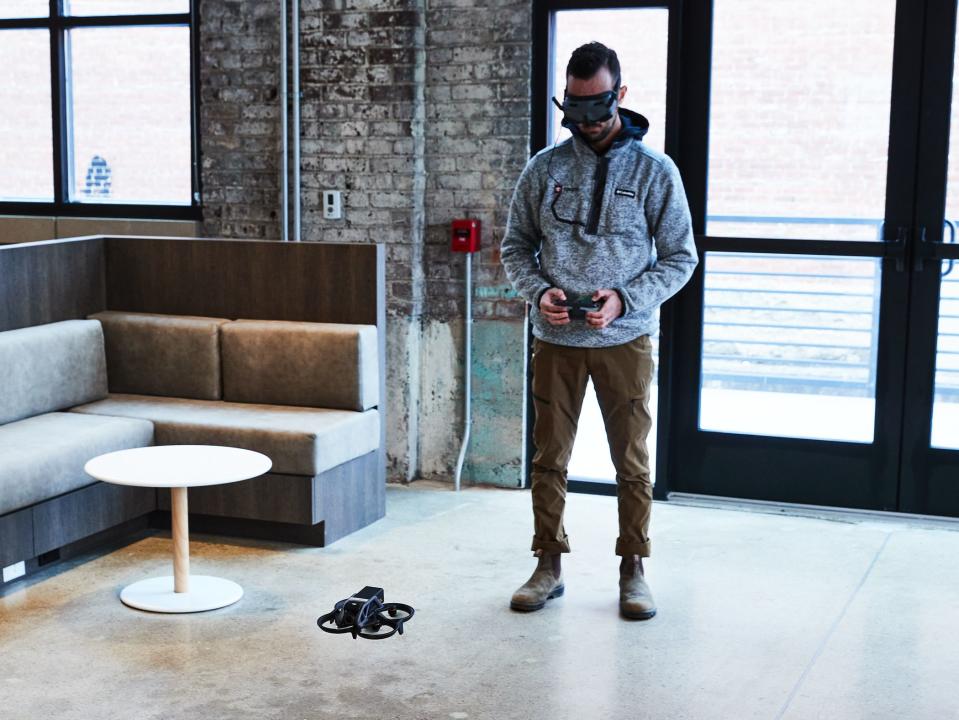
In addition to leaning on personal experience and knowledge, we recruited other drone pros to help with the selection process, as they spend thousands of hours a year flying and testing whatever drone they can get their hands on.
“Knowing what’s coming next is really part of my job,” says Matt Sloane, CEO of Skyfire Consulting in Atlanta. Sloane began his company seven years ago to help firefighters and emergency ops use drones as tools to get more “eyes on the situation.” Sloane says most SWAT teams, for instance, would happily (and wisely) risk a drone rather than an officer, and Sloane himself not only has commercial drone licensing, but he also has his commercial license to fly manned aircraft.
We also tapped Billy Kyle for his knowledge of piloting drones. Kyle is the founder of Atmos Aerial near Philadelphia, a professional surveying company that he says mostly entails delicately flying around construction sites, and conducting aerial mapping for farmers and real estate firms. Kyle also reviews drones and offers quick guidance through instructional videos on YouTube.
Most of our selections are based on the expertise of Crisara, Sloane, and Kyle, based on hands-on experience and familiarity with these brands. Two picks—best value and best for kids—were chosen according to extensive research, reading guides and publications on the best drone of today, user reviews, and brand reputation.
These drones are an assembly of unmanned aircraft for hobbyists, beginners, covering all budgets and skill levels.
Mini 2 Drone
Sloane recommends the Mini 2 to anyone who thinks they want to get into drones but isn’t dead certain. He says it’s easy to fly and has multiple modes, such as a very slow “cinematic” setting designed to capture smooth video, that guardrail novice flyers. One key feature for learners, too, is built-in GPS. “Beginners lose sight of a drone above a tree line,” Sloane notes, “and that’s that. It’s gone forever.” GPS, however, enables you to tap “return to home” on the app, and that tells the Mini 2 to fly itself back to the launch point.
The drone is quite stable, too, able to fly in level 5 wind. And yet, at only 249 grams, it falls just below the weight bar that would require FAA registration. Video and stills resolution is on par with those of a smartphone, and even though the digital zoom of 4x doesn’t produce astonishing video, it’s a handy tool for figuring out the drone’s proximity to nearby objects.
The drawbacks of the Mini 2 versus DJI’s other drones? The smaller camera sensor can’t take in as much light, so shooting at sunrise or sunset won’t be as sharp, and it’s missing some more advanced video options, too. Further, it doesn’t have the higher-tech sensing for trickier flying scenarios, preventing crashes.
All that said, the Mini 2 can still take beautiful stills and video. And because it’s so stable and beginner-friendly, there’s no better model to learn on. Sloane says it’s the drone he takes, more often than not, when “I just want to fly for fun.”
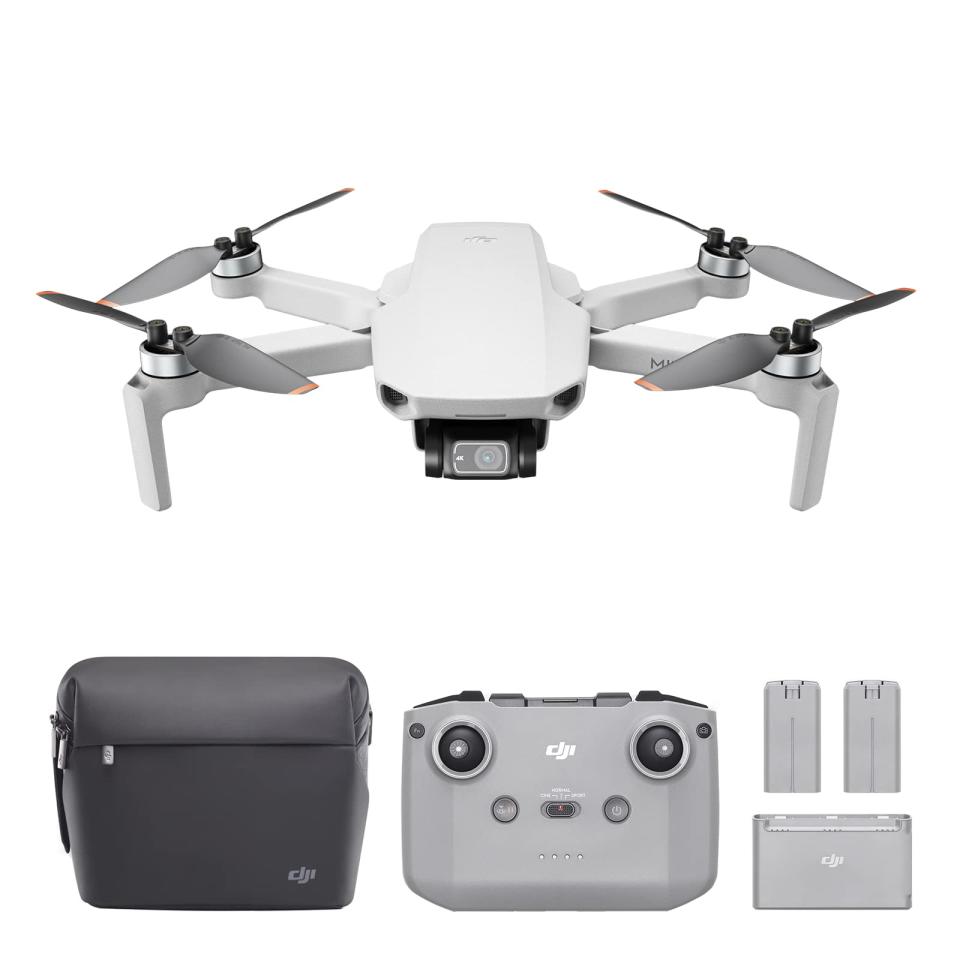
Mini 2 Drone
amazon.com
$798.00
Atom SE Drone
One of Potensic’s newer models, the Atom SE is a direct competitor to DJI’s Mini 2 but loaded with extras. It shares identical cameras with the Mini 2, plus it comes with its own carrying case. It nearly doubles the battery power when factoring in the extra included battery, giving this drone roughly one hour of flight time per excursion (granted you land the machine to swap batteries).
This tiny device has a 4K HD camera with stabilization tech to help the 12-MP photos and 4K, 30-fps footage come out clear. It also has a control system with three modes—including video, normal, and sport—and plenty of tracking modes. A GPS-assisted return home button sets the drone to fly back to you in case of emergencies. It can withstand level 5 wind.
The Atom SE is a frequently recommended value-forward product from Reddit drone enthusiasts. Several user reviews say that the Atom SE is great for beginners and experienced users alike and comment on its easy software, surprisingly well-made construction, and terrific controller. However, some say its lack of obstacle avoidance can make flight feel risky for new users.
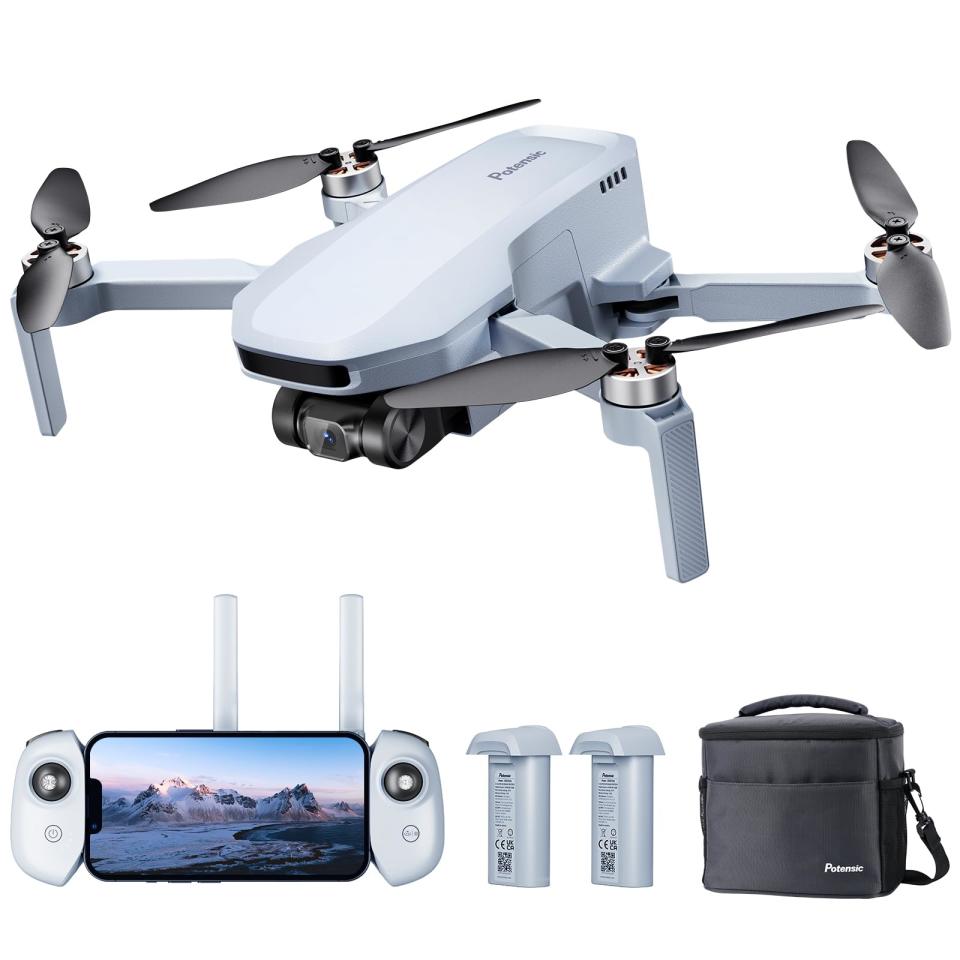
Atom SE Drone
amazon.com
$249.99
Mavic Air 2 Drone
Kyle thinks the Mavic Air 2 is the perfect “tweener drone,” because it gives you some of the higher level camera capabilities of the most expensive Autel and Mavic 2 Pro drones, as well as more advanced sensing technology, without an eye-watering price tag. Among the key camera features is the ability to shoot 8K hyperlapse. The hyperlapse feature is time-lapse video, but do note that’s a battery-intensive mode that only lets you launch, fly a bit, record, and then immediately land.
Likewise, 48-MP image capture is a digital trick that takes multiple images simultaneously. It doesn’t replicate the crystal-clear photography you get from the larger sensor on DJI’s Mavic 2 Pro. Still, the feature set of the Air 2 is excellent.
For instance, the Point of Interest 3.0 mode allows the Air 2 to create an automated flight path around an object (think: 360 degrees around a boat in the water); Spotlight 2.0 lets you tap an object, like a person, in the viewfinder to keep the camera fixed on that subject, so you can focus on flying while the subject moves.
The Mavic Air 2 also has forward, backward, and downward sensing, distinguishing it from the Mavic Mini 2, which lacks sensors.
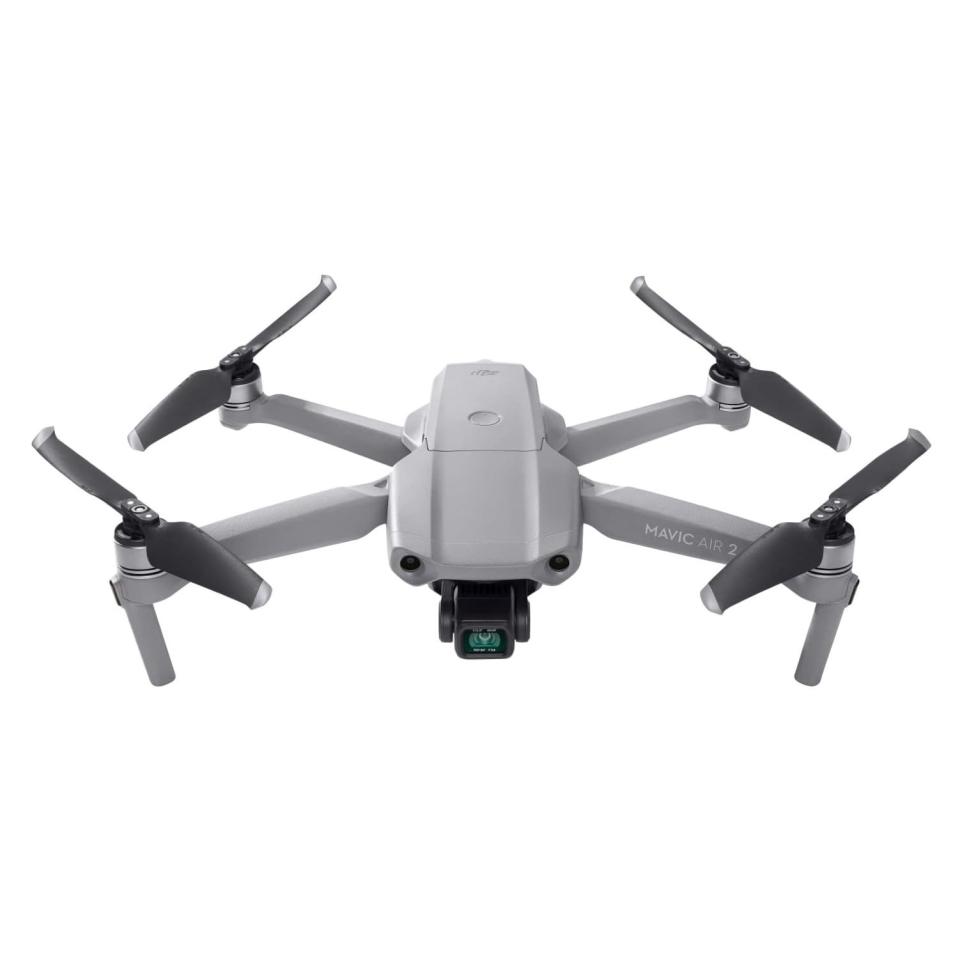
Mavic Air 2 Drone
amazon.com
$827.00
Mavic 3
The Mavic 3, as its price may indicate, is one of DJI’s flagship models, and for good reason. For a high price, professional photographers and aerial enthusiasts can pilot this thing to take color-accurate videos and vibrant photographs with three powerful cameras.
It has one wide-angle Hasselblad (a Swedish brand) camera and two telephoto cameras—one with a 70mm lens and another with 166mm (in layman’s terms, 28x zoom). These telephotos are especially nice for cutting into the impressive scenes you can see with the wide-angle to get a compressed, smooth view of trees swaying or people walking up a mountain.
You can toggle between shooting video in 5.1K at 50fps or 4K at 120fps, plus the device’s sensors help capture more data and color information than the other DJI drones, making the photo editing process more customizable (and, frankly, more professional).
Omnidirectional obstacle sensing gives you peace of mind when flying this out of sight and reach, so you won’t have to worry much about crashing. It also has an impressively long range. If you can swing the price, it’ll do well, but keep in mind that this may be overkill for the casual user.
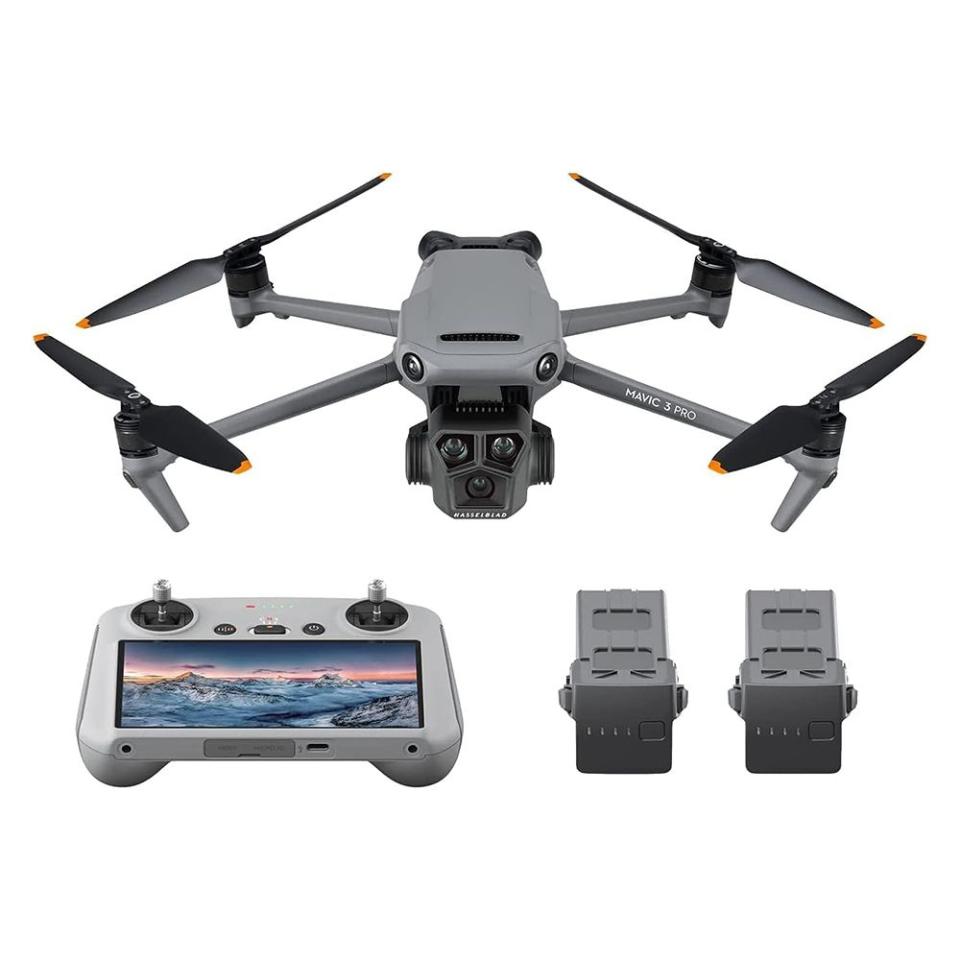
Mavic 3
amazon.com
$2999.00
You Might Also Like

